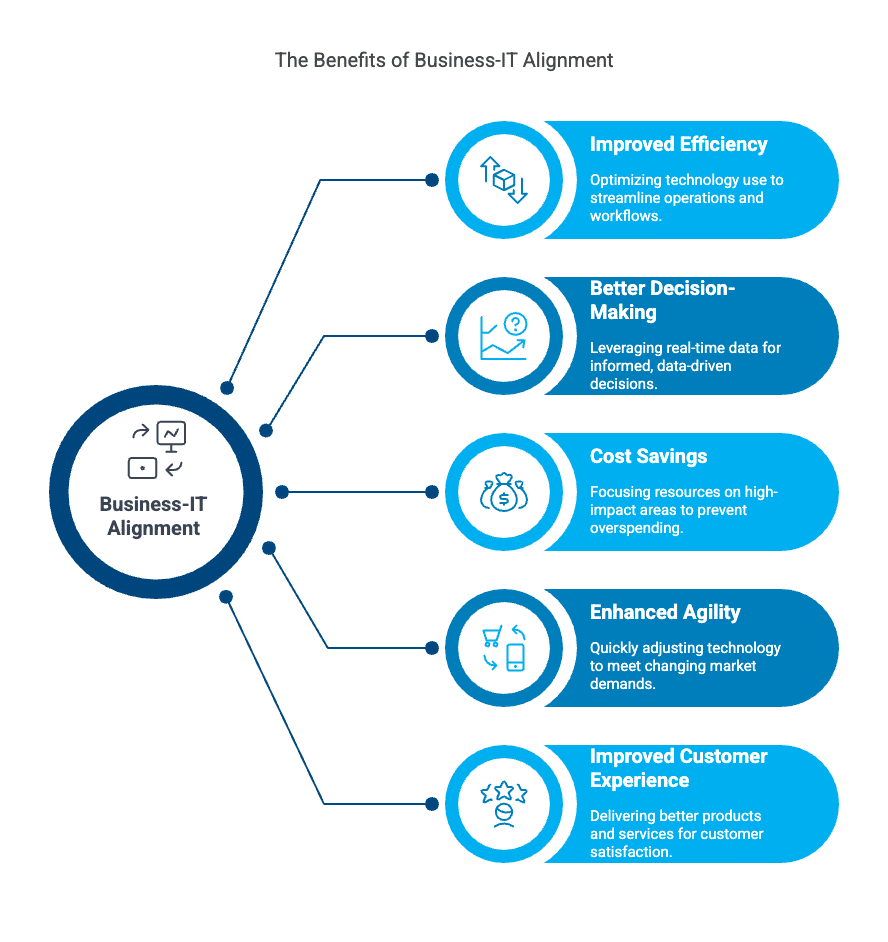Technology and digital solutions are necessary for all modern businesses to deliver their products and services. But many businesses only choose the technology they are already familiar with, and don’t bother to consider industry-specific alternatives or more advanced systems that would serve them better.
To succeed in business, you must have a business strategy. If you don’t have an IT strategy, your company will fall behind the competition and fail to take advantage of a shifting marketplace. Bringing these two components together is where businesses can really start to make strides towards their strategic goals.
What is Business-IT Alignment?
Business-IT alignment is the process of ensuring that a company’s technology strategy is fully synchronized with its overall business objectives. It’s about making sure that IT initiatives directly support the company’s goals, whether that’s improving customer experience, reducing operational costs, or driving innovation.
Rather than viewing IT as just a support function, aligned businesses treat it as an integral part of their strategy. This approach enables technology to be leveraged as a tool for competitive advantage, helping the business achieve its goals more efficiently.

Benefits of Business-IT Alignment
Improved Efficiency: When IT and business strategies are aligned, companies can optimize their use of technology to eliminate redundancies and streamline operations. This results in smoother workflows and faster project delivery.
Better Decision-Making: With IT systems aligned to support business objectives, decision-makers can leverage accurate, real-time data. This helps leaders make informed, data-driven decisions that directly contribute to the company’s growth and success.
Cost Savings: By aligning IT investments with business priorities, companies can focus their resources on high-impact areas. This prevents overspending on unnecessary tech tools and ensures return on investment (ROI) with technology purchases.
Enhanced Agility: Companies can quickly adjust their technology infrastructure to meet changing market demands, scale operations, and support new business initiatives.
Improved Customer Experience: When IT is aligned with business goals, it can help deliver better products and services to customers. For example, IT systems that support a seamless, data-driven customer experience can lead to greater satisfaction and loyalty.
Risks of Poor Alignment
When IT strategy fails to align with business objectives, organizations face several risks that can hinder growth and productivity.
Wasted Resources: One of the biggest risks of poor alignment is investing in technology that doesn’t support the company’s core business objectives. This leads to wasted resources, as IT budgets are spent on systems or projects that provide little value.
Missed Opportunities: Without proper alignment, businesses may miss out on opportunities to innovate or adopt new technologies that could give them a competitive edge. Poor alignment can also slow down digital transformation efforts, leaving companies behind more agile competitors.
Increased Complexity and Downtime: Misalignment between IT and business goals can lead to overly complex systems that are difficult to manage and prone to failure. This increases the risk of technical disruptions, downtime, and inefficiencies that can harm the business’s overall performance.
Aligning IT with Business Strategy in 5 Steps
1. Understand Business Goals
The first and most critical step in aligning IT with business objectives is ensuring that IT leaders have a solid understanding of the company’s goals, mission, and overall strategy. This includes understanding both short-term strategic priorities and long-term visions, as well as recognizing the key challenges the business faces.
How to do it: IT leadership should actively engage in high-level business discussions and strategic planning sessions. This means IT should be present at the executive level to better understand where the company is heading and what specific outcomes are expected from the technology department. By understanding the broader business context, IT teams can align their initiatives with business growth drivers, like expanding into new markets, improving customer satisfaction, or optimizing operations.
2. Collaborative Planning Between IT and Business Teams
Strategic alignment can’t happen in isolation. Both sides—IT and business—need to work closely together. This ensures that IT strategies are built with a clear understanding of business needs, while business leaders are aware of how technology can support and enable their long-term goals.
How to do it: Encourage regular, structured communication between IT and business departments. Cross-functional team members should collaborate to discuss upcoming business initiatives and identify where technology can play a role. IT can ensure that the necessary infrastructure, data analytics, and security measures are in place to support a rollout.
Joint Accountability: Create a governance structure where IT and business leaders share accountability for the success of IT initiatives. This could include setting up joint committees or steering groups to oversee projects.
3. Regular Monitoring and Adjustment
Business needs change, and so do the demands on IT. Continuous alignment requires regular monitoring and adjustments to ensure IT strategies remain relevant and aligned with evolving business goals. Without ongoing evaluation, misalignment can creep in as projects lose focus or business priorities shift.
How to do it: Implement a feedback loop where business outcomes are continuously measured against IT performance. Use key performance indicators (KPIs) that matter to both IT and business, such as customer satisfaction or time-to-market. This can help track whether IT initiatives are delivering the desired business results.
Agility in IT: Ensure that IT operations remain flexible and capable of adapting to changing business requirements. This could mean adopting agile methodologies in software development or being prepared to pivot quickly when business strategies shift.
4. Invest in Scalable and Flexible Technology
Business growth often brings unforeseen changes, from increased customer demand to entering new markets. To keep up, IT systems need to be scalable and adaptable. Investing in technology that can grow and change with the business helps ensure that IT infrastructure supports long-term business goals.
How to do it: Prioritize cloud-based services, modular software, and scalable infrastructure that can adjust as business needs evolve. Cloud platforms, for example, allow businesses to expand their computing resources quickly without major overhauls.
Future-Proofing: Stay proactive by anticipating future technological trends and how they may impact the business. For example, AI, automation, and data analytics can offer competitive advantages—investing in these areas early ensures the company is prepared to adopt emerging technologies that align with its goals.
5. Focus on Building a Technology-Driven Culture
Business-IT alignment is not just about business processes and IT systems—it also involves fostering a culture where technology is viewed as a strategic asset. When the entire organization values IT as a partner in achieving business success, alignment naturally follows.
How to do it: Encourage collaboration between IT and non-IT departments, promoting a mindset that sees technology as an enabler of innovation and efficiency. Regularly highlight success stories where IT played a key role in driving business outcomes. Additionally, ensure that employees have the necessary skills and training to leverage technology effectively in their daily roles.
Leadership Buy-In: Alignment works best when it starts at the top. Business leaders should champion the role of IT in the organization and emphasize its importance in achieving key business objectives. This sends a clear message to the rest of the organization that IT is a critical partner in driving success.
Align Your Business and IT Strategy with Expert Guidance
Achieving business-IT alignment is an ongoing process, but when IT strategies are fully synchronized with business operations and objectives, companies will find their goals are much easier to reach.
At Davenport Group, we can help you align your business goals with your tech stack and IT strategy. We’ll tailor an IT roadmap that takes into account your particular goals, challenges, and budget. Reach out to us for a consultation, and let’s find out how we can make your vision a reality.
